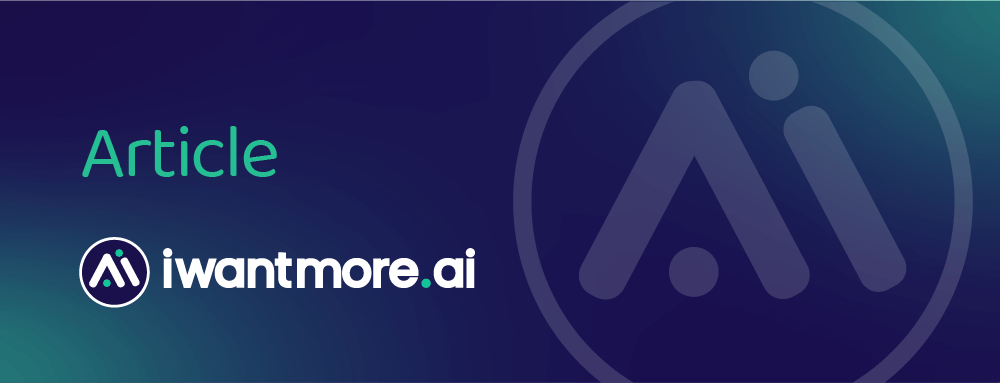
AI for business – nice to have or a competitive necessity?
The decision to adopt AI is no longer about jumping on the latest tech trend; it’s about survival. Sound overdramatic? Here’s what the Chief Product Officer at Cisco, Jeetu Patel, had to say about it in their latest AI readiness report.
“Eventually, there will be only two kinds of companies: those that are AI companies, and those that are irrelevant.”
(Incidentally, if you’re not sure how ready or not your business is for AI, take our quick AI readiness assessment.)
Now this message may be on the strong side, but for businesses who choose to delay or ignore implementing AI into their workflows and business, the risks are real, and the consequences could be significant.
Have you made the shift in mindset from AI as a nice to have, to a competitive necessity?
It’s been clear for a while now that companies that have embraced AI are seeing significant benefits across various sectors – i’m not sure this can be disputed anymore. This ranges from companies like Grind Coffee working with Google across multiple use cases, such as writing product descriptions, or emails to customers, to Klarna’s AI assistant that has already had 2.3 million customer service conversations.
AI is providing that competitive edge.
What are the risks of sitting on the fence and not adopting AI?
The first reaction of many business leaders is to look at the risks of implementing AI: privacy and security, bias, ethical concerns, accuracy. The list is actually quite long. This is probably why so many companies have locked down access to tools like ChatGPT.
But for businesses still on the fence, or even behind the fence, the risks of inaction need to be weighed up. Here are a few areas to consider for companies opting to ignore or postpone implementing AI:
1. Falling behind your competitors:
If your competitors are using AI, (and i’m generalising here) they can, more than likely, make faster, data-driven decisions with tools like Tableau, improve customer experiences with the likes of Zoho, and optimise their operations with the amazing Make.com. If you have fewer insights into how your business is performing, don’t know what your clients think and feel and have manual process throughout your operations, you are going to be losing clients to competitors who are more efficient and innovative.
2. Operational inefficiencies:
We mentioned manual processes a second ago, but it’s so important it’s worth calling out on its own. Without AI (and automation), businesses will be reliant on manual processes that consume valuable time and resources. This inefficiency can erode profitability and in many cases can be fixed with no-code tools like Zapier or Make.com for very little cost.
3. Missed growth opportunities:
There are a whole host of AI-powered tools that can create new revenue streams – whether through analysing customer behaviours with tools like Sprig, or predicting market trends with Quid. Without AI, these insights might remain untapped, leaving revenue on the table.
4. Talent drain:
If you don’t have AI infused across your organisation to eliminate mundane tasks, but your competitors do – who will win the war for talent? Forward-thinking employees want to work with the latest technologies. Businesses that are resistant to adopting AI may struggle to hire and retain top talent.
But if AI is so great, why are there still barriers to AI adoption?
In Slack’s recent Workforce Index, they report that executive urgency to incorporate AI tools into business operations has increased 7x over the past six months and is now a top concern, above inflation or the broader economy, and yet more than two-thirds of desk workers have never used AI at work.
So why aren’t people using AI at work?
There are a few primary barriers that hold many businesses back, including cost concerns, or lack of expertise, either at the technical level or skills such as prompting. However these can be solved pretty easily. It’s the non-obvious barriers that need looking at. Slack’s Workforce Index highlighted a few barriers I hadn’t considered before:
- The value of original ideas – 47% said that using AI feels like cheating.
- The value of effort – 46% of workers equate their value to effort and fear being seen as lazy for using AI.
These are clear leadership challenges that need a human level response. So how do you address these?
Build change management into your AI strategy
If your AI strategy doesn’t consider change management and communications, now is the time to address that:
It all about culture – addressing concerns about originality and effort in AI use requires leaders to foster a culture that reframes AI as a tool for adding value rather than cheating.
Reward the experimenters – leaders should recognise and reward outcomes over effort alone. Show that using AI to work smarter, not harder, is a skill.
Communicate – clear communication, training, and setting transparent guidelines on AI’s role in the workplace will help employees feel empowered rather than judged.
Don’t sit on the fence, the time to act on AI is now.
Find out where you are with AI today, educate your team, identify use cases and build an AI strategy with people at the centre.
If you want help with AI readiness, AI training or developing your AI strategy, contact us.
Other AI articles you may be interested in:

At iwantmore.ai, we help businesses navigate the world of AI. One of the persisting challenges we see is the perception by some people that using AI is 'cheating.' Despite AI’s proven advantages, some professionals still feel uneasy about embracing it leading to a culture where employees secretly use AI tools to avoid judgment.

Every company seems to want to use AI. According to Cisco’s second annual AI readiness report, 98% of executives felt an increased urgency to deliver on AI. Many businesses are already implementing it in some way, but based on the findings of the RAND report, more than 80% of AI projects fail.

Every few days, a new AI model seems to drop from one of the big AI companies. But as a normal person, how do you work out whether a new AI model is actually better than what you were using before? In this article we look at ways in which you can test out which model is most applicable for your business needs.

From boardrooms to marketing teams, leaders in businesses are being told they need AI to stay competitive. But amid the hype and noise, one crucial question often gets overlooked - what’s the actual return on investment (ROI)? Is it all worth the effort?

We take a look at the various ChatGPT modules and find out which ones best suited for what business tasks. We look at GPT-4o, GPT-4o Mini, GPT-4, OpenAI o1, OpenAI o1 Mini, OpenAI o1 Pro Mode, OpenAI o3 Mini and look at what they are best for, their purpose and how you access these models.

There’s still some confusion as to what an AI agent actually is. In many cases it’s probably still just simple automation with a fancy name. But at the more sophisticated end of the spectrum, these autonomous systems have the potential to change the way businesses operate.
iwantmore.ai – The AI consulting firm that helps you build a smarter business
Wherever you are with your AI implementation initiatives, we have a range of stand-alone AI quick start services to help you fast track the transformative benefits of AI across your business.



